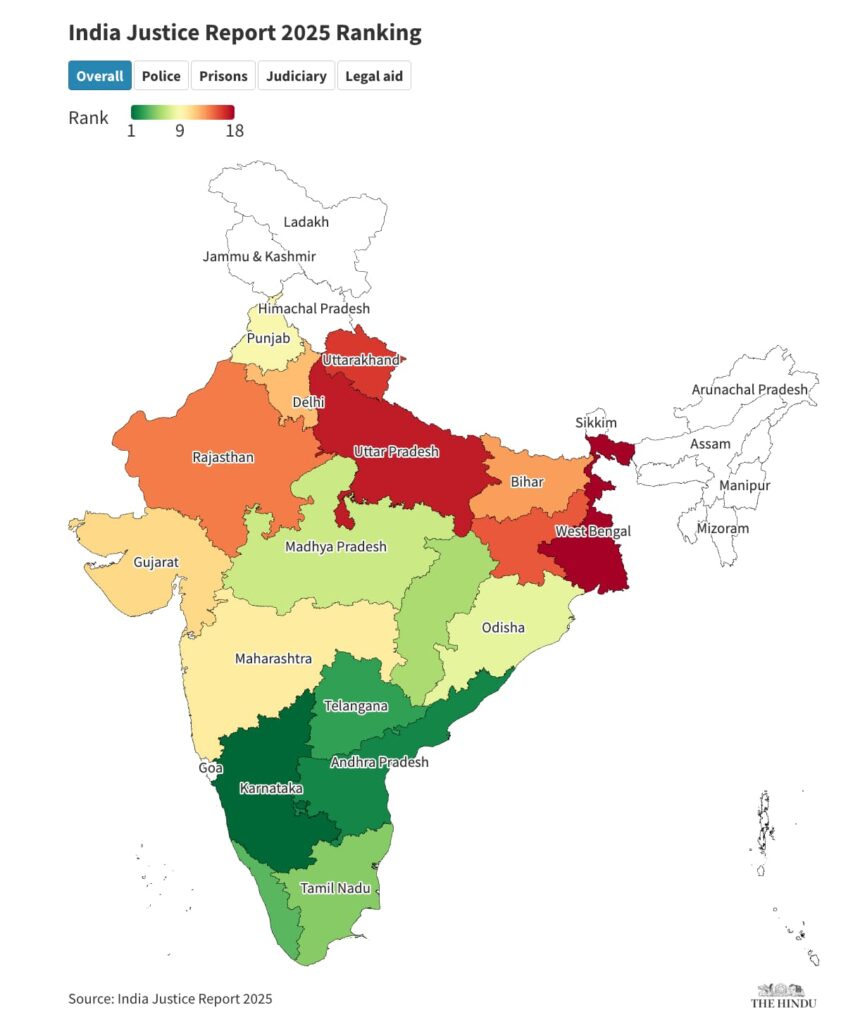Context: India Justice Report 2025 was released recently. It has revealed that with a national average occupancy rate of more than 131%, Indian jails face extreme overcrowding and are battling multiple health challenges.
India Justice Report (IJR) 2025
Published by:
Tata Trusts
In collaboration with various civil society organisations and data partners
Objective:
To track and assess State-wise performance across four pillars of the justice system:
Police
Judiciary
Prisons
Legal Aid
Methodology:
Based entirely on official government data
Evaluates performance using key indicators, such as:
Budget allocation: Financial resources dedicated to justice delivery
Human resource availability: Adequacy of judges, police personnel, legal aid providers, etc.
Infrastructure: Availability and quality of physical and digital infrastructure
Workload: Caseload per judge, pendency rates, staff-to-population ratios, etc.
Gender diversity: Representation of women in the justice system workforce
Coverage:
Includes all 36 States and Union Territories of India

I. Issues with the Prison System in India
1. Severe Overcrowding
National average occupancy rate: Over 131%, indicating serious overcrowding.
Projected inmate population by 2030: Estimated to reach 6.8 lakh.
Expected prison capacity by 2030: Only 5.15 lakh, far short of projected needs.
2012–2022 trend:
Inmate population grew from 3.8 lakh to 5.7 lakh (approx. 50% rise).
Prison capacity increased only from 3.4 lakh to 4.3 lakh (just 27% rise).
Uttar Pradesh: Has the most overcrowded prisons in the country.
Delhi: Alarmingly, 91% of prison inmates are undertrials, not yet convicted.
2. Public Health Crisis
Medical staff shortage:
43% vacancies in positions for Medical Officers.
Doctor-to-prisoner ratio: 1:775, far exceeding the recommended 1:300 (Model Prison Manual).
Data gaps:
Lack of comprehensive data on inmates with disabilities, whether pre-existing or acquired during incarceration.
3. Mental Health Crisis
Severe shortfall of mental health professionals:
Only 25 psychologists/psychiatrists available for 5.7 lakh inmates.
Ratio: 1 per 22,929 inmates (vs. benchmark of 1 per 500).
Widespread absence of services:
25 States/UTs lack any provision for correctional mental health professionals.
4. Inadequate Prison Expenditure
Spending per prisoner (2022–23): ₹44,110 annually.
An increase from ₹38,028 in 2021–22.
Still insufficient given the rising number of inmates and the complexity of their needs.
II. Issues with Policing in India
1. Low Representation of Women
Less than 1,000 women hold senior police positions across India out of a total 20.3 lakh personnel.
No State or Union Territory has fulfilled its own reserved quotas for women in police forces.
2. Infrastructure Gaps
17% of police stations still lack CCTV surveillance.
Almost 30% of police stations do not have Women Help Desks, limiting support for gender-based crimes.
3. Resource Allocation
Per capita police spending: ₹1,275 — the highest among all four pillars (Police, Judiciary, Prisons, Legal Aid).
Civil police personnel ratio: 1 officer per 831 people, reflecting inadequate staff for growing population demands.
III. Issues with the Judiciary
1. Vacancies and Pendency
Uttar Pradesh: Over 50% of High Court judge positions remain vacant.
Gujarat: Leads in High Court judge and staff vacancies.
Bihar: 71% of trial and district court cases have been pending for over 3 years, reflecting serious case backlog.
2. Judiciary Spending
Per capita judiciary spending: Only ₹182 per annum.
No State allocates more than 1% of its total budget to the judiciary — revealing chronic underfunding.
IV. Issues with Legal Aid
1. Budgetary Constraints
Per capita legal aid spending: A mere ₹6 annually — the lowest among the four pillars.
Raises concerns about accessibility and quality of free legal services for marginalized communities.
